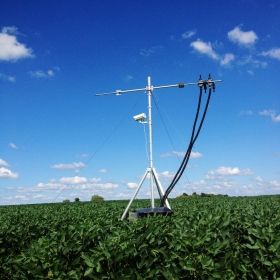Twelve-foot metal poles with long outstretched arms dot a Midwestern soybean field to monitor an invisible array of light emitted by crops. This light can reveal the plants’ photosynthetic performance throughout the growing season, according to newly published research by the University of Illinois.
“Photosynthetic performance is a key trait to monitor as it directly translates to yield potential,” said Kaiyu Guan, an assistant professor in the College of Agriculture, Consumer, and Environmental Sciences (ACES) and the principal investigator of this research. “This method enables us to rapidly and nondestructively monitor how well plants perform in various conditions like never before.”
Published in the Journal of Geophysical Research – Biogeosciences, the Illinois team led by Guofang Miao, a postdoctoral researcher in ACES and the lead author of the paper, report the first continuous field season to use sun-induced fluorescence (SIF) data to determine how soybeans respond to fluctuating light levels and environmental stresses.
“Since the recent discovery of using satellite SIF signals to measure photosynthesis, scientists have been exploring the potential to apply SIF technology to better agricultural ecosystems,” said study collaborator Carl Bernacchi, an associate professor of plant science at the Carl R. Woese Institute for Genomic Biology (IGB). “This research advances our understanding of crop physiology and SIF at a local scale, which will pave the way for satellite observations to monitor plant health and yields over vast areas of cropland.”
Read more at Carl R. Woese Institute for Genomic Biology, University of Illinois at Urbana-Champaign
Image: Scientists evaluate the photosynthetic performance of soybeans using these towers, which use hyperspectral cameras to capture light invisible to the human eye that may one day help us predict yield on a grand scale. (Credit: Guofang Miao)


